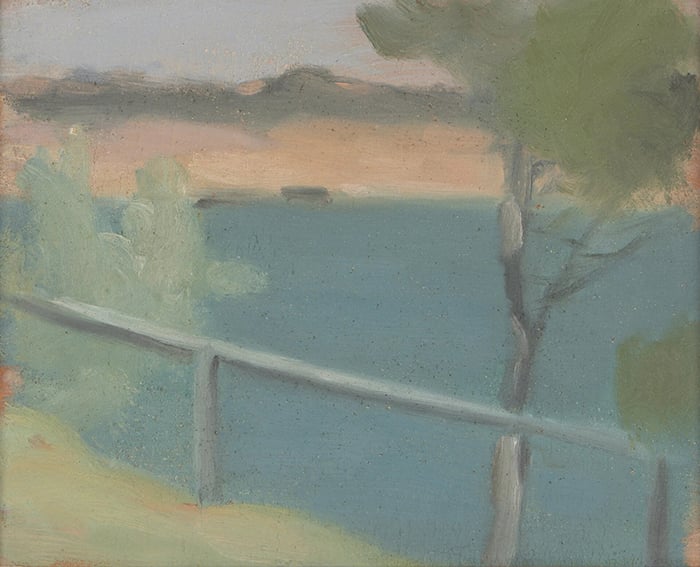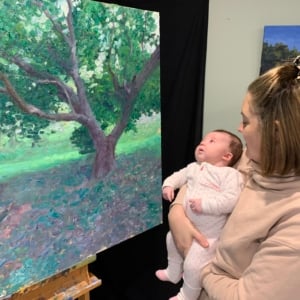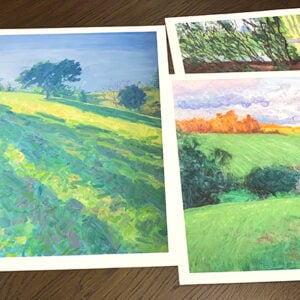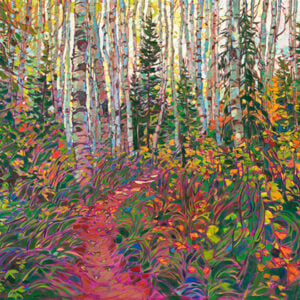“To give a sincere and truthful representation of a portion of the beauty of Nature, and to show the charm of light and shade, which I try to give forth in correct tones so as to give as nearly as possible an exact illusion of reality.” Clarice Beckett
Today’s featured artist is Clarice Beckett. One of my newsletter subscribers recommended I check out her work. She was unknown to me before that, which is surprising given her influence in the Australian art scene, her prolific activity with a brush, and the interesting story of her life. Let’s take a closer look at her life and work.

Overview of Her Life
Beckett was born in Casterton, Victoria, Australia, on 21 March 1887. She was a shy and artistic child. This shyness seems to be reflected in the paintings she would go on to create, such as Solitude.

(Sidenote: It’s interesting to think how our childhood and upbringing might influence our work as adults. I’m sure there’s a strong correlation, though I have nothing to back this up.)
She studied under two famous Australian artists: Frederick McCubbin and Max Meldrum. Not bad company to learn from! Meldrum seems to have had a stronger influence on Beckett’s life and work. He was the founder of Australian tonalism and a two-time Archibald Prize winner (1939 and 1940).
She typically painted plein air (outdoors) and favored ordinary subjects—city streets, suburban houses, street lights, bridges, beaches, parked cars, sunsets, sunrises, and hazy mornings and afternoons. Her body of work provides insight into what everyday life was like in Melbourne at the time.

Her family was largely unsupportive of her artistic endeavors. See the below text by the Art Gallery of South Australia.
“During her lifetime Clarice Beckett was denied the use of a dedicated painting studio. She had asked for a studio to be made available for her in the family’s newly designed home at Beaumaris. Her request was ignored and, when the family moved in 1919, her father declared that ‘the kitchen table would do’.
Her kitchen studio was also the room in which she painted her still lifes. It was also where she assembled her paintings – side by side along the skirting boards – to assess them before installing her exhibitions. She staged successive solo exhibitions at the Athenaeum Gallery in Melbourne between 1923 and 1933. The still lifes she exhibited were among her most admired works.” Art Gallery of South Australia
(Sidenote: Beckett only painted a handful of still lifes (that we know of) and she painted them with tighter brushwork and a more classical style. This may have appealed to the conservative critics of the time, but I think her best works are her plein air landscapes and seascapes. They are more fresh and lively and honest.)

Despite the lack of support, she was prolific with a brush and painted around 2,000 works. Sadly, most have since been lost or destroyed. Her father, of all people, destroyed many of her paintings as he deemed them ‘unfinished’ and too abstract.
Her life was cut short in 1935. She was caught in a storm whilst painting plein air and developed pneumonia. Her name and work faded into obscurity for many years. Interest was reignited when curator and historian Rosalind Hollinrake started championing her work after discovering many of her paintings stored away in a farmer’s barn.
Today, she’s appreciated in a much kinder and brighter light. Various galleries and museums have showcased her work, including the Art Gallery of South Australia and the National Gallery of Australia. In 2021, the Art Gallery of South Australia held a major retrospective of her work titled The Present Moment. There’s also an annual Clarice Beckett Art Award presented by the City of Kingston in Victoria, Australia. And here I am, writing about her now!
Focus on Mood and Atmosphere
Her work is moody and atmospheric. The subject seems to have been merely a vehicle for her to convey atmosphere, mood, and color. This is typical of Tonalism and also Impressionism.
This focus on mood and atmosphere is most effective when paired with subjects of that same nature, such as hazy mornings and afternoons, sunrises, and sunsets. Below are a few examples. This is Beckett’s work at its best, in my opinion.



I’m not sure if her style works as well for more cheery and bright subjects. Take her painting, Spring Morning, for example. Her wispy brushwork and soft edges seem to play against the subject’s nature. My eyes are left itching for a few hard edges and bursts of clarity. But that’s just me!

Tip: When exploring famous artists like this, take them down from the pedestal and critique them as a peer. Look for areas that you might improve on. This isn’t about being negative or overly critical; rather, it’s about judging their work objectively and without all the romanticism.
Simplified Detail and Relaxed, Impressionistic Brushwork
Beckett was vague in her description of subjects, doing just enough for us to know what the painting is about and not a single stroke more. She let simple color shapes do most of the work and ignored the frills. At best, painting in this way can produce honest and clear glimpses of how the artist sees the world. At worst, it can appear bland and unfinished. The key is being spot-on with the fundamentals and injecting a bit of personality and flare, which Beckett did.

One of the benefits of simplifying the subject like this is that it reduces the overall noise and focuses attention on the important details. When I look at Beckett’s work, my eyes aren’t overrun with information and detail and there’s no confusion as to where she wants me to look.

The simplified detail works particularly well for her serine landscapes, like View Across the Yarra. Here there’s complete alignment between the subject’s nature, Beckett’s brushwork and style, and the simplified detail.

Beckett used relaxed, impressionistic brushwork. This may have been partly due to stylistic preference and partly due to the demands of plein air paintings. When painting plein air, the environment, the subject, and the colors change rapidly in front of you. You must paint fast to capture it.
It seems she typically painted alla prima (wet on wet) and with a thin layer of paint, sometimes just enough to cover the surface. You can see what I mean in Evening Scene, shown below. The thin layer of paint allows part of the surface below to show through and it gives the paint a slightly transparent, ethereal finish, even when opaque colors are involved.

Limited Palette and Soft, Pastel Colors
Beckett was restrained in her use of color, using a limited palette and relying mostly on grays and soft pastel colors. These paintings won’t command attention in a gallery room, but they do have a quiet beauty about them.

Even her paintings of the sun at sunrise or sunset feature restrained oranges and yellows. Using color in this way promotes a sense of harmony and unity throughout the painting, as the colors share a common theme in value and/or saturation. Daniel Garber’s work also comes to mind. He often painted bright landscapes with muted and high-key (light) colors.

Another theme you’ll see in Beckett’s work is a few bursts of strong or vivid color amongst a sea of grays or weak colors. See Beach Scene below. This is a tried and true approach. The vivid and muted colors complement each other, with the vivid colors drawing attention and acting as exclamation points and the muted colors adding context and providing a stage for the vivid colors to shine.

Passing Trams is another example. This is also a great demonstration of color relativity. Look how those strokes of orange—which are weak and tinted, far from pure cadmium orange—stand out amongst the grays. If you ever want to draw attention to a particular color, surround it with colors that won’t compete for attention.

Gallery of Her Work
Here are some more of Beckett’s paintings that I’m particularly fond of:














Helpful Links and Resources
Here are some helpful links and resources to learn more about her life and work:
S.H. Ervin Gallery: Press release about the 1999 exhibition of her work titled Politically Incorrect.
Art Gallery of South Australia: Detailed article on Beckett’s life and work.
Mutual Art: Extensive showcase of her work.
Wikipedia: More details about her life and work.
Wikipedia: Details about her most significant teacher, Max Meldrum.
Australian Dictionary of Biography: Short biography by Rosalind Hollinrake.
National Gallery of Victoria (Video): Clarice Beckett, A Leading Female Artist.
Paul Ingbretson (Video): Student of Max Meldrum discussing Beckett’s work.
Thanks for Reading!
I appreciate you taking the time to read this post. Feel free to share with friends. Let me know your thoughts in the comments.
Happy painting!
Dan Scott

Draw Paint Academy







Thank you for this great article!!! Going to research to see if any of her work is available in US
Hi Dan, I went to Clarice Beckett’s exhibition here at the Geelong Art Gallery two days ago. I had no expectations, and was very happy I went. Beckett’s work is ethereal and the way she portrays light is superb. Her painting ‘Spring Morning, 1925’ needs to be seen personally to really appreciate it, I couldn’t take my eyes off it! I went straight home to try and emulate her style, still working on it. Well worth a trip to lovely Geelong if you’re close enough.
I am also working on a sunrise in her style….muted horizon, tonal colours, not too much detail and flat surface with brush( I usually use a palette knife). I mixed beeswax in with acrylic to try to achieve the matt look…. so far, enjoying the result.
good luck with yours!
Impressionists certainly leave an impression……as with this artist, it is not so much what the eye sees as what the heart feels!
Clarice Beckett’s work had a way of abstracting her scenes creating a very peaceful atmospheric and dreamy environments. Loved Trees Beside the Yarra, Church Street Bridge, and View Across the Yarra.
Thanks for sharing.
Love these works. The everyday of things, the gentleness and the unfocused views.
Wonderful.
I always read your articles and study the paintings. This is the first time I felt compelled to comment. Clarice Beckett’s painting appealed to me very much. Serene, uncomplicated works of art. Thank you for posting this article!
Very interesting view of her paintings
Thanks for your dialogues e critiques
Love this! So true about younger artists’ work reflecting their moods and feelings. Just saw mini-exhibit by high school students who won Arts for Life scholarships here in Florida – all expressed impact of their feelings in their art.
Thank you for highlighting this artist. I am now a big fan. I love her soft colors and minimal detail style. Her work evokes emotion in me. I feel what she saw. As opposed to most oil paintings which convey what the artists saw, not felt.
Thank you for sharing her work which I loved.
Very calming work, makes one very mellow.
Love the simplicity that speaks to the soul.
Thanks for sharing this, makes a person think they try too hard. We just need to follow those feelings and thoughts inside instead of forcing ourselves to do the perfect painting.
Lots to ponder.
Rena, I agree with your statement, ” . . .makes a person think they try too hard. We just need to follow those feelings and thoughts inside instead of forcing ourselves to do the perfect painting.” It is almost as if you are saying, “we should follow our hearts rather than our head.” and there is a big difference between the two. Frances – USA
Share Rena’s thoughts and comments.
Thanks for sharing,
Charlotte
There is an exhibition of Clarice Beckett’s work on at the moment at the Geelong Gallery, on until 9 July- well worth a look and a mention in your profile of her?
https://www.geelonggallery.org.au/claricebeckettatmosphere
Interesting work. I feel that she was restrained with a limited palette, perhaps because she had no family financial support to help. I am also wondering if she was perhaps very short sighted? Could this account for the lack of detail and blurred images in her paintings?
This is a wonderful article about Clarice Beckett! My grandfather was Percy Leason who studied with Meldrum at the same time as Clarice. Grandpa was very fond of Clarice and thought highly of her art. It is so nice to see her continuing to receive appreciation and exposure to her beautiful work.
I have loved Clarice Beckett’s paintings for several years now. Her Tonalist/Impressionist style is very soft and calm and to myself, relaxing. Without seeing the paintings ‘in person’ I find it hard to discern her method(s) of attack although to my eyes it does seem she became slightly more bold with color as she progressed. Thanks so much for sharing her with us all. As is often said, many times ‘Less is More’….
Thank you Dan! I love Beckett’s soft edges and muted colors, also how she made a limited palette speak volumes. Inspiring, makes me want to play with this soft technique.
Very nice article about a new-to-me artist. Her style has a relaxing quality to it. I appreciated the information about her life and how she painted in spite of having so little support from her family. Thank you Dan for such a wonderful post!
Thank you for sharing. I love Wet Evening and Church Street Bridge such a shame so much of her work lost or destroyed. Childhood made an extreme impact on my artwork so much so I’ve never considered myself an artist only a mere reproduction it even though works are often unique. Should you delve deeper into this I should be most interested on your findings. Thanks again.
Thank you for sharing this wonderful artist with us, Dan. Your comment “Her work is moody and atmospheric. The subject seems to have been merely a vehicle for her to convey atmosphere, mood, and color.” The atmosphere, mood and colour calls me to marvel at how she did so much with so little. Working with such a limited palette is always a challenge for me. Again, thank you.
I was left wondering — how did a Model T get to Australia? Plan to do a little research on that interesting tidbit. Beautiful calm work. Inspiring! Love her palette’s.
Thank you Dan, for this wonderful article on Clarice Beckett and for the extensive gallery of her work. I love that she continued to make her art despite the repressed and suppressed family life. What might she have achieved with support and encouragement?
Loved this post and learned so much!
Really inspiring. I love the soft tones and the colour harmony.
I also have just visited Geelong to see “Atmosphere”. The works are beautiful. Some are seemingly unfinished (I think hindsight might call them abstracted)- I suppose whatever could be rescued including her studies- some are only on cardboard, unsigned and still in very 70’s frames. The paint is very matt. I thought I knew her work – the bayside and Melbourne city scenes- but I discovered rural landscapes and her love of sunrise and sunset. It is interesting to see such a body of her work together and I love Ros Hollinrake’s dedication to resurrecting her art and story since the 70s.
Thank Dan. I came across her works about 30 years ago in Melbourne. My mum was a teacher who inspired us to follow Australian artists and we visit the galleries often. My relatives live in Beaumaris and we tried to visualise the sites where she painted from. She had a remarkable gift for this plein air style. What a battle for her as a female artist in that era! Wish I can get down there to visit her exhibition.
Many thanks for sharing. Interesting never heard of this artist before. Now I know Merci.
Hi Dan
I haven’t commented before, but this newsletter has prompted me to. As one who paints to the edges and fills in the spaces (even when I’m trying not to), Clarice’s work is revelatory. Thanks for the critique. Like you, I felt some pics might have been improved with a more defined edge or contrast. Those like Beach Scene I loved, but the more unfocussed Tranquility and View Across the Yarra I also loved.
This is so timely Dan, as I’m going to see her exhibition in Geelong tomorrow.
Thank you for sharing Clarice Beckett’s story and work. I very rarely comment on artist sites, stories or galleries, but her work was very thought-provoking and interesting. I look forward to accessing the links provided to learn more. Thank you.
I really enjoyed this. The beautiful light and masterful use of simplified colour is delightful to view. I love our homeland, so being introduced to another female Australian artists work is a real joy
Thanks for sharing a great artist profile once again Dan. She reminds us that less can be more and we need not over burden ourselves with detail. I like Picasso’s view that painting can be learned quite quickly but it takes a lifetime to paint like a child.
Thank you Dan,
First comment ever. When I look at her paintings one by one it seems as if time has stood still and you are in a soft space. She fondles with every brushstroke her ideas on canvas.
Love, love, love this.
Thanks again,
Sunny greetings,
Ciska
Hi Dan,
Just a correction. The Annual Clarice Beckett Art Award, inaugurated 12 years ago, is held in Casterton, Beckett’s birthplace. Casterton is in the Glenelg Shire in the Western District of Victoria, about a five-hour drive from Kingston Council area. Thank you for sharing the link to ‘our’ award page! Great post, but the way!
Jenn
For Artists of the Valley
The more I looked at her art, the more I liked it. Yet when I came to the Marigolds, I gasped. The background is so subtle and so well done even to the soft designation of the table on which the vase is setting. Then, did you notice how well she made the crystal vase appear as crystal? Awesome. And then, to top it off {the subtlety of the background and surroundings} she pops out these gorgeous, brilliant marigolds. Wow! I would buy this art in a HeartBeat.
Dan – Thank you for introducing me to Clarice Beckett’s art! Her fresh, impressionistic style and muted palette are splendid. These paintings inspire me. I was in need of that inspiration today. I’m going to spend more time taking in these images. Just wonderful!
Patricia
Thanks for writing about her work, I’d certainly never heard of her. Wonderful stuff.
I was amazed at how much story she conveyed in her simple work. Studying her characters on Sandringham Beach I found a pregnant lady (identified by her posture) and a horseback rider, all subtly done and yet with a strong knowledge of form.
Except for the bridge, I hate the style she uses on your favorites. LOL!